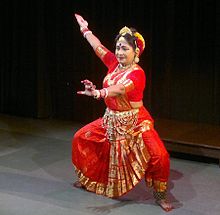

| Instrument(s) | Anaddha, Ghana, Susir and Tata[1] |
|---|---|
| Origin | West Bengal, India |

Gaudiya Nritya (Bengali: Gaur̤īẏa Nṛtya or Gour̤īyo Nrityo) is a dance tradition.[2][3][4] This dance expressed religious stories[5] through songs written[6] and composed to the ragas & talas[7]ofGaudiya music by ancient poets, especially Vaishnavism.[8] Gaudiya Nritya performances have also expressed ideas of other traditions related to the Hindu deities Shiva[8] and Ganesha, as well as Shakta concepts.[9] It was reconstructed by Mahua Mukherjee in the 1980s and a research scholarship has since been awarded for it by the Indian Ministry of Culture.
On 21 September 1994, The name Gaudiya Nritya was adopted on the advice of Indologist Bratindra Nath Mukhopadhyay.[10] Reasons for this designation include: in ancient times – the reign of Shashanka and the Pala and Sena eras – the whole of Bengal was referred to as Gauda and the presence of the Gaudiya styleinIndian music and literature. Also, in the fifteenth century, Sangeet Shastrakar Maheswara Mohapatra of Odisha mentions seven types of dance styles in Abhinaya Chandrika including Gaudiya dance.[11]
The theoretical foundations of Gaurika dance can be found in the ancient Sanskrit text Natyashastra;[12] Its existence in ancient times is attested by dance poses in sculptures of the Gaudiya style temple and archaeological sites associated with Hinduism, Buddhism and Jainism and it is mentioned by ancient poets of Bengal.[13] After India's independence from colonial rule, it underwent revival, reconstruction and expansion in the 1980s.
It has been reconstructed by Mahua Mukherjee, a Bengali researcher and dancer.[4][14] A research scholarship was awarded by the Ministry of Culture for this dance-based research,[15][16] which is mainly offered to recognized Indian classical dances. Rabindra Bharati University and University of Oklahoma have recognized it as a classical dance form.[17][18][19][20]
{{cite book}}: CS1 maint: location (link){{cite book}}: CS1 maint: location (link)
![]() Media related to Gaudiya Nritya at Wikimedia Commons
Media related to Gaudiya Nritya at Wikimedia Commons
|
| |||||
|---|---|---|---|---|---|
| Cuisine |
| ||||
| Dance |
| ||||
| Music |
| ||||
| Handlooms and handicrafts |
| ||||
| Observations and festivals |
| ||||
| Arts |
| ||||
| Other |
| ||||
|
| |||||
|---|---|---|---|---|---|
| Ancient |
| ||||
| Classical |
| ||||
| Divine forms |
| ||||
| Folk (list) |
| ||||
| Contemporary |
| ||||
| Literature |
| ||||
| By state |
| ||||
| Accessories |
| ||||
|
| |||||||
|---|---|---|---|---|---|---|---|
| Society |
| ||||||
| Religion |
| ||||||
| Culture |
| ||||||
| Folk culture |
| ||||||
| Others |
| ||||||
This article about Indian dance is a stub. You can help Wikipedia by expanding it. |